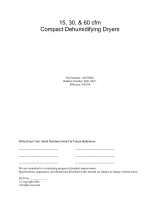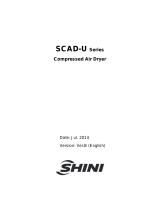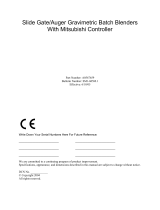Sterling SCD 10 User manual
- Category
- Tumble dryers
- Type
- User manual
This manual is also suitable for
Sterling SCD 10 is a compressed air dryer designed to remove moisture from compressed air. It uses a refrigeration method to cool the air, causing the moisture to condense and be removed. The Sterling SCD 10 is capable of handling airflows of up to 10 CFM and can reduce the dew point of the air to as low as 35°F. This makes it ideal for use in applications where dry air is required, such as in painting, electronics manufacturing, and food processing.
The Sterling SCD 10 is easy to install and operate. It comes with a wall-mounted bracket for easy installation, and the controls are simple and intuitive. The dryer also has a number of safety features, including a high-temperature safety system and an airflow monitoring safety system.
Sterling SCD 10 is a compressed air dryer designed to remove moisture from compressed air. It uses a refrigeration method to cool the air, causing the moisture to condense and be removed. The Sterling SCD 10 is capable of handling airflows of up to 10 CFM and can reduce the dew point of the air to as low as 35°F. This makes it ideal for use in applications where dry air is required, such as in painting, electronics manufacturing, and food processing.
The Sterling SCD 10 is easy to install and operate. It comes with a wall-mounted bracket for easy installation, and the controls are simple and intuitive. The dryer also has a number of safety features, including a high-temperature safety system and an airflow monitoring safety system.




















-
 1
1
-
 2
2
-
 3
3
-
 4
4
-
 5
5
-
 6
6
-
 7
7
-
 8
8
-
 9
9
-
 10
10
-
 11
11
-
 12
12
-
 13
13
-
 14
14
-
 15
15
-
 16
16
-
 17
17
-
 18
18
-
 19
19
-
 20
20
-
 21
21
-
 22
22
-
 23
23
-
 24
24
-
 25
25
-
 26
26
-
 27
27
-
 28
28
-
 29
29
-
 30
30
Sterling SCD 10 User manual
- Category
- Tumble dryers
- Type
- User manual
- This manual is also suitable for
Sterling SCD 10 is a compressed air dryer designed to remove moisture from compressed air. It uses a refrigeration method to cool the air, causing the moisture to condense and be removed. The Sterling SCD 10 is capable of handling airflows of up to 10 CFM and can reduce the dew point of the air to as low as 35°F. This makes it ideal for use in applications where dry air is required, such as in painting, electronics manufacturing, and food processing.
The Sterling SCD 10 is easy to install and operate. It comes with a wall-mounted bracket for easy installation, and the controls are simple and intuitive. The dryer also has a number of safety features, including a high-temperature safety system and an airflow monitoring safety system.
Ask a question and I''ll find the answer in the document
Finding information in a document is now easier with AI
Related papers
-
Sterling Clothes Dryer 882.00291.00 User manual
-
Sterling 882.00291.00 User manual
-
Sterling Clothes Dryer 882.00290.00 User manual
-
Sterling DH1-610-2 User manual
-
Sterling STT 500 User manual
-
Sterling Dehumidifier STT 300 User manual
-
Sterling STT 800 User manual
-
Sterling stt 1600 User manual
-
Sterling STT 110 User manual
-
Sterling STT 110 User manual
Other documents
-
Conair 106 User manual
-
 ACS A0570882 User manual
ACS A0570882 User manual
-
Matsui DMZ-240 User manual
-
 Shini SCAD-6U User manual
Shini SCAD-6U User manual
-
Kenmore KMFLTEZ3 Operating instructions
-
GE RH30 Warranties
-
 Mitsubishi Electronics A0567659 User manual
Mitsubishi Electronics A0567659 User manual
-
Bunn ULTRA-1 User manual
-
Central Pneumatic Item 42202 Owner's manual
-
Bunn Ultra-2 HP White/Stainless, Manual Fill, Extended Handle User manual
































